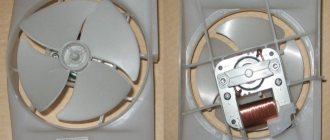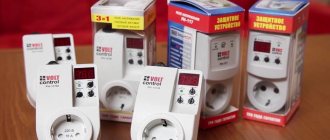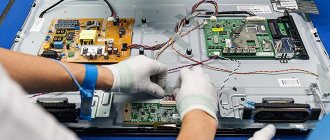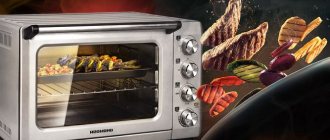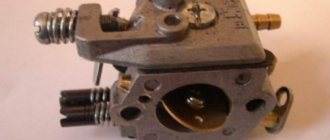Do-it-yourself microwave repair
Repairing a microwave oven requires special professional knowledge and skills. But with a little knowledge of the basics of electrical and radio engineering, and knowing how to use electrical tools, you can try to cope with this problem, even if you are a builder, musician or doctor. To make repairs yourself, just remember what you were taught at school during labor lessons. In this case, you must follow electrical safety rules: do not make short circuits when connecting wires, and do not stick your fingers into the socket. If you are not confident in yourself, then it is better to contact a specialist service center.
Principle of operation
After connecting the microwave to the network, a voltage of 220V is supplied to the first winding of the transformer. Automatically the voltage is transferred to the secondary winding. The chamber heating system starts. Due to the fact that these two windings are isolated from each other, safe operation of the microwave oven is ensured. A microwave oven allows you to heat food at high speeds by using double the voltage. In this circuit, the main role is played by a capacitor, to which a diode is connected in parallel. The duration and magnitude of the temperature regime helps to control the temperature sensor and a regular timer. For safe use, the oven has a built-in power protection relay, the function of which is to stop the operation of the microwave in the event of high voltage drops in the network or when the door is open. If all this description seems complicated to you, then don’t worry: we’ll figure it out now.
Signs of a microwave oven breakdown
Most often, external signs of a microwave oven malfunctioning are the appearance of sparks, puffs of smoke, the plate stopping from rotating, and the lack of heating of food placed in the oven. Or the microwave simply won’t turn on. In this case, it is dangerous to plug it into the network! There are three main reasons for electrical appliance failure:
- Fuses blown;
- Magnetron malfunction;
- Burnout of the mica plate.
In case of this type of breakdown, you can repair the stove if you follow the instructions strictly. First, consider the functional diagram of a microwave oven. We take the functional diagram because It makes it easier to understand the operating principle of a microwave oven, it is universal, regardless of the brand of the oven, it is simpler compared to the circuit diagram of a microwave oven.
And the location of the microwave elements can be seen in this figure:
Fuse blown
This is the most common cause of failure. There are two fuses in the microwave. The first F1, the so-called mains fuse, is located at the input of the 220 volt mains voltage into the microwave oven. So he can burn out. In this case, the oven stops turning on and does not react in any way when you press any buttons. First, you need to diagnose the microwave oven: remove the mounting screws from the back side and open the protective panel. Do not forget to unplug the plug from the socket before starting repair work. Then you need to forcefully discharge the filter capacitor. To do this, its terminals are closed (i.e., connected to each other) using an insulated wire. Be sure to hold the wire strictly by its insulation. After this, check for voltage on the surge protector board and check the condition of the microwave power wires. If there are no faults in this part, you should inspect the diode in the rectifier circuit of the power supply. Most often, it is this that causes the fuse to blow in this type of breakdown. The fuse in the microwave should be checked for openness visually or using an ohmmeter, if necessary, replace it with a serviceable one and analyze the causes of the blown, in order to avoid a repetition of a similar situation, paying attention to various darkening of the radio elements, which indicate a malfunction in the microwave units. The second fuse F2 is located after the high-voltage transformer in the magnetron circuit and is called high-voltage. It is “hidden” in a plastic tube-shaped case and located next to the transformer. This fuse fails due to the failure of a high-voltage diode or capacitor. It is better to replace the fuse with a new factory-made one. it is calibrated for the desired operating current. Well, it is imperative to replace the part that led to the fuse burning. Below, watch a video about how, as a last resort, you can repair a high-voltage microwave oven fuse yourself:
Finding a problem: a clear action plan
Does the stove turn off after starting or after 3 seconds from the start of operation? If the MVP turns on and immediately turns off, as we have already said, check the voltage in the outlet. Is it 220V? Then proceed like this:
- Inspect the power cord. If you find blackened or burnt (melted) insulation on the wires, take care to replace it. You also need to clean the contacts and terminals with a metal brush.
- Check the condition of the fuses on the filter . Upon inspection you should not find any defects. To measure the resistance of fuses, use a tester or ohmmeter.
- Inspect the thermal fuse. If burned out, replace.
- If all of the above is in order, it is worth determining whether voltage is supplied to the primary winding of the control unit transformer . If not, check the secondary winding. If there is no voltage there, then the primary winding is probably burnt out and a new transformer is needed.
- Is the control unit faulty? As we have already said, repairing it requires special knowledge. Repairs can cost a pretty penny, so sometimes it’s easier to replace the unit with a new one.
Magnetron malfunction
If the backlight works in the oven, the plate rotates, but the microwave does not heat the food, then most likely the cause of the malfunction is a malfunction of the magnetron. In the above diagram, the magnetron is designated as “magnetron”. A magnetron is a device that generates microwave radiation. That is why if this part fails, the oven does not heat.
The magnetron is housed in a small rectangular metal housing. First you need to clean it and then carry out a visual inspection. Next, inspect the magnetron unit itself. Namely, the integrity of the wires connecting the terminals and the housing. Often the reason the magnetron does not work is the failure of the feed-through capacitor. Below watch the video on how to repair a microwave oven magnetron with your own hands:
After this, be sure to check the microwave control unit. Again, pay attention to burnt, sooty and dirty areas. It is these parts that will need to be replaced for the microwave to continue operating.
Diagnosis and Troubleshooting
High voltage fuse blown
Among the common breakdowns is a malfunction of the high voltage fuse. In the event of a breakdown, the microwave stops turning on and no longer responds to button presses. Before carrying out diagnostics, it is necessary to discharge the high-voltage capacitor, and then remove the protective casing by unscrewing the fastening screws. Next, using an ampere-voltmeter, you should check the voltage in the surge protector.
Most often, the diode is located on the power filter board. If a part burns out, it should be replaced immediately. After the repair, it is necessary to find out the cause of the overload, which is why the fuse failed.
If swelling or darkening is found on the parts of the device, it is necessary to check the control unit. If after replacing the fuse there is no change in the operation of the device, the problem may lie in the transformer board.
Magnetron malfunction
This is the most common malfunction that awaits microwave oven owners. If the stove does not heat up, you need to understand the operation of the magnetron. To detect damage, inspect the internal walls of the device. If there is no mechanical damage, remove the plate from the left side of the compartment and clean it with a weak alcohol solution. After cleaning, you can begin checking the functionality of the element. If darkening or burnt holes are detected, replace the faulty mechanism.
After cleaning the surfaces, you can begin diagnosing the unit. To detect a breakdown, visually inspect the condition of the insulation between the device body and the terminals. Resistance in the area being diagnosed indicates a malfunction of the capacitors in the filter. In this case, repairs may be limited to replacing the filter and capacitor unit. Next, you should inspect the metal cap and, if damaged, replace it with a new one.
Burnt mica plate
Another common cause of microwave problems is a burnt mica plate. However, this malfunction can be repaired with your own hands. One of the symptoms of a breakdown is sparks in the wave channel area. Why did this happen and how to fix it?
During the cooking process, some products may splatter, resulting in the mica becoming soggy. To avoid future damage, cook and reheat food only in sealed containers. So, what to do if you couldn’t prevent burnout:
- Stock up on working tools: scissors, sandpaper, an awl and a file.
- Unscrew the top cover and door of the device.
- Take out the old plate and magnetron.
- Use a file to file the waveguide slot.
- Get rid of sharp metal edges caused by mica burning.
- Clean the wave channel with sandpaper.
- Treat burnt equipment parts.
- Remove dirt from the inner chamber and wave channel.
- Inspect the magnetron unit.
- Replace the metal cap if necessary.
- Using the instructions, install the magnetron.
- Screw the door leaves.
- Start the stove by placing a bowl of water inside.
- Apply a new layer of mica to the burnt plate.
- Trace the outline of the plate using an awl.
- Install the mica plate.
Common microwave oven failures and how to detect them
If your microwave oven does not work well or does not turn on at all, you can repair it yourself by finding the cause of the malfunction. Basically, all models of microwave ovens have the same device, and therefore they break down in almost the same way.
The microwave does not heat and there is a smell of burnt insulation.
- Short circuit between the turns of the transformer. The resistance of the primary winding of a working transformer is in the range of 2.3 - 3 Ohms. If the resistance measured with a multimeter is less than 2 ohms, this means that an interturn short circuit has occurred in the winding. The resistance of the secondary high-voltage winding should be about 150 Ohms. If, after taking measurements between the device body and the high-voltage terminal, you find a significant resistance deviation or a winding break, it means the transformer is damaged.
- Breakdown of a high-voltage capacitor. The resistance of a working capacitor should not be less than 10 MOhm, and also not equal to infinity, because this indicates an open circuit.
- Failure of the high voltage diode. Everything is simple here, if during measurement the diode shows a resistance close to zero, it means it is broken.
- The magnetron burned out. A voltage of 4 kV is supplied from the high-voltage, filament winding of the transformer to the magnetron, therefore, if the insulation is broken, breakdown easily occurs from the wave emitter to the housing. In this case, the magnetron cap often melts.
The microwave oven does not turn on and the program cannot be set.
- The power socket is faulty. First, make sure there is voltage at the outlet. Connect the appliance to a different outlet.
- The fuse has blown. If the mains voltage is connected, but the stove does not turn on, most likely one of the two fuses has blown. The first fuse is a fuse and is installed in the power supply circuit from the mains voltage. The second fuse is a temperature sensor, which is located on the surface of the heating chamber.
- The micro switch is broken. When the small limit switch is broken, then its open contacts do not signal the electronic control module to close the door, and the oven does not turn on.
- The control module or board is faulty. A conclusion about the failure of the control module can be made only after the following have been checked: fuses, micro-switch, furnace transformer. But if individual buttons on the control module did not work before, then it is probably broken.
The microwave oven sparks inside.
- The magnetron cover is burnt out. The mica plate located inside the heating chamber on the right side is often carburized. This occurs when the surface of the emitter cover, contaminated with splashes of grease, begins to burn during operation of the oven.
- Damage to enamel. Do not try to restore the insulating coating inside the heating chamber with ordinary paints or putties, as the fumes from these non-specialized products will poison the food.
- Broken door latch. Replace the broken latch as quickly as possible, because when the door is not tightly closed, microwaves come out of the inner chamber and irradiate everyone who is near the microwave oven.
The microwave oven does not stop after the timer ends.
- Relay is faulty. This intermediate relay connects voltage to the primary winding of the transformer. The cause of the relay malfunction may be its mechanical failure, or burnt contacts.
- The control module or board is faulty. You need to check the control module with keys, and it is better to replace it.
The tray does not rotate in the microwave oven.
- Malfunction of the plate rotation drive. If one tooth breaks off on a plastic gear, you can replace it with a metal insert. But if the gear is worn evenly, it will have to be replaced.
- The drive motor has failed. A restored broken engine will still not work for long after repair, so it is better to buy a new one.
The microwave oven is overheating.
- Wrong choice of location for installing the stove. Do not install the microwave oven close to other heating devices or in direct sunlight, otherwise it will quickly overheat during operation.
- Fan failure. This device can break down both mechanically and electrically. In any case, you will have to disassemble the fan, and if necessary, replace its blades, motor bearings, or the entire electric motor.
The grill does not work in the microwave oven.
- The heating element has burned out. It is very easy to check a tubular electric heater: if, when measured with a multimeter, the resistance at the contacts is equal to infinity, then the heating element is unusable.
The lighting lamp does not light.
- The lamp has burned out. If the backlight does not work, check the incandescent lamp first.
- The backlight switching circuit is broken. After replacing the lamp, the backlight still does not work - this means there is no contact with the power circuit of the lighting lamp.
Where does the “survey” begin?
Knowledge of the device that needs repair is a plus, but often it is not very necessary. Having found a suitable person (or several) from the list of “suspects” of the microwave malfunction, proceed to the following steps:
- The device is turned off from the network. Being careful not to touch the capacitor, carefully remove the cover located on the rear panel.
- They discharge the capacitor, even if the furnace has not worked for quite a long time.
- Check the fuse. If a loss of integrity is detected (the hairs have turned black and torn), then the device is replaced.
- The transformer is examined: it is disconnected from the contacts, then the resistance of the windings is measured. The norm for them is 1.4 Ohm (primary), 110-120 Ohm (secondary), maximum 0.1 Ohm (incandescent).
- A relay is connected to the light bulb. Very bright light or its absence are symptoms of a breakdown.
Common microwave oven malfunctions and their causes
We have long been accustomed to heating and defrosting food in the microwave. The microwave oven has long and firmly entered our everyday life and won its place there. And when suddenly this useful device fails, it greatly upsets us. If you have some knowledge in the field of electromechanics and radio engineering, then in the event of a minor breakdown, you can try to repair the microwave oven yourself. But if a significant malfunction occurs or your knowledge is insufficient, it is better to use the services of a professional technician.
Why do microwave ovens break down?
It is believed that a microwave oven is a fairly reliable unit that rarely fails. And most often, the reasons for its breakdown are improper operation and wear of parts during long-term use of the device. So why might a microwave break?
- When heating, utensils that are not suitable for microwave use are used. Only glass or plastic containers can be used in the SChV. The container lid must be open. When heating with a tightly closed lid, the cookware may explode, which will damage the inner chamber and parts of the stove.
- There is a metal object in the microwave while it is running. Often, users leave cutlery in dishes, which can lead to sparking, cracking and puncture on the inner surface of the chamber. The same consequences will result from using metal utensils or utensils with foil patterns applied to them.
- When heating food, a special plastic cap is not used. It protects the chamber walls and internal elements from contamination by drops of liquid and fat that evaporate from the surface of the dish when heated.
Features of repair of some brands
The causes of breakdowns for different brands are identical, but the repair of a certain brand may differ slightly from its analogues. Let's look at the features of the most popular brands of microwave machines.
| Samsung | Microwave ovens from Samsung rarely break down - the mechanical parts are very strong, so problems with latches can be eliminated by almost 99%. If there is a malfunction, you should immediately check the electronics. |
| Rolsen | The Rolsen brand cannot boast of impeccable reliability. Breakdowns and even short circuits of equipment are common, so it’s worth looking for a different brand. |
| Panasonic | Budget models from the Panasonic brand often suffer from rust. This will not directly lead to malfunctions, but will accelerate the wear and tear of the equipment. |
| LG | Another brand of microwave ovens that is reliable. But there are also two weak points in the LV: fuses and capacitors - they must be checked first. |
Also popular brands of equipment include:
- Sharp is a popular brand with a wide range of sizes, but the actual size of the camera may be smaller than stated;
- Supra is a budget equipment with normal quality, sometimes breakdowns occur, but most customers are satisfied;
- Elenberg is also a budget brand, but has a short warranty - only for a year;
- Bork - models are distinguished by high functionality and stylish appearance, but we must take into account that the brand is Russian, and the spare parts are Chinese;
- Scarlett is a British brand that wanted to produce equipment in Russia, but still chose China;
- Daewoo is one of the leaders in electronics, simple controls and stylish models, low cost and good quality. There are retro models;
- Erisson - simple, concise and budget models. Ideal for a cottage or rented apartment;
- Vitek is a very popular brand, there are many models with different numbers of functions.
Diagnosing microwave malfunctions
You can determine whether a microwave oven is truly hollow using the method of elimination. To do this, inspect the unit and check the functioning of the following elements:
- You need to start by checking the integrity of the power cord and outlet. If there is a break in the cord or an overloaded outlet, the microwave will not work. Here you should pay attention that the microwave oven is sensitive to the mains voltage. If the voltage is lower than 220 volts, the device does not work.
- The next step is to check the tightness of the door closure. Microwaves are dangerous to human health. And therefore the oven is designed in such a way that it can operate with the door tightly closed. If the lock on the door, the locking system or the closing element is broken, the microwave will not turn on.
- The last step is to check the fuse and thermal relay. The mains fuse may blow due to a sudden voltage drop in the network or a short circuit. If you replace the fuse, the device will work properly. The thermal relay turns off the operation of the device when the door is open. If the thermostat is not working properly, it needs to be replaced.
Fan is faulty
Symptoms: The microwave turns off earlier than expected or periodically turns on and off
A broken microwave fan will not cool the appliance, and the protective relay will turn off the microwave. The fan motor or blades may break, the bearing may crumble or become seized, or there may be problems with the power supply to the fan motor or with the speed controller. To repair or replace the fan and its components, it is better to call an experienced specialist who will carefully check everything, select the necessary parts and issue a guarantee.
If the fan does not cool well, then it is not necessarily a problem: it may simply become clogged. Dirt and grease can build up thickly on the blades, slowing their rotation, and food and other debris can get caught in the bearing or between the starter and engine rotor. If traces of dirt are clearly visible on the fan, thoroughly clean its blades and internal components.
Basic malfunctions of microwave ovens
Microwave won't turn on
There may be several reasons why the microwave oven does not turn on:
- The power cord is faulty. It may be broken or the wire contacts have come loose from the control board. The malfunction can be eliminated by soldering the contacts, and if the problem is in the cord, by replacing it.
- The high voltage fuse has blown. It needs to be replaced.
- The door lock microswitch is broken. It needs to be replaced or the contacts restored.
- The thermostat is not working. Here you need to figure out whether the thermostat has burned out and needs to be replaced, or there is a malfunction in the cooling system of the furnace chamber. A competent technician will be able to figure out the problem.
- The control board has failed. Frequent causes of this malfunction are voltage surges. The step-down transformer on the board most often fails, and various radio elements of the supply circuit break less often.
The plate doesn't spin
The plate rotates poorly or does not rotate at all due to a malfunction of the motor that rotates the tray. Most often, the engine breaks down due to drops of water, grease and food particles adhering to the shaft. This leads to difficulty in rotating the shaft, increasing the load on the coil and causing it to burn out. If rotation difficulties arise, the shaft can be carefully cleaned of dirt. If the coil burns out, it needs to be replaced.
Another reason may be a violation of the integrity of the electrical circuit.
Microwave doesn't heat
- The fuse has blown. It needs to be replaced.
- Magnetron failure. The causes of such breakdowns can be voltage surges in the network, short circuit, capacitor malfunction, as well as element wear. A qualified technician can deal with the causes of magnetron malfunction.
- The network voltage is below 220V.
Sparking and crackling in the microwave chamber
Such signs indicate that the mica platinum has burned out. The reason for this is heating food in an open container. This causes liquid and fat to evaporate from the surface of the dish and settle on the plate. Also, mica can burn out if there is any metal object, even a small one, in the chamber. Or excessive wetting of the plate during cleaning.
The microwave oven makes a loud noise
If operated for a long time at maximum mode, the magnetron may fail. A short circuit may also occur in one of the windings of the high-voltage transformer, which also leads to increased sound. Fan malfunction also results in increased sound and noise.
Touchpad buttons don't work
During operation, the contacts on the buttons are broken. They require restoration, or a complete replacement of the button or touch panel. Also, the lack of response to pressing a button may indicate a malfunction of the control unit.
The light in the oven chamber does not light up
The chamber light turns on when the door is opened and while the microwave is operating. The absence of backlight indicates that the light bulb has exhausted its life and has burned out. It needs to be replaced. Less often, the light bulb does not light up due to wiring faults.
These and many other microwave malfunctions can be easily fixed by a technician from. We have been working with all brands of microwave ovens for more than 15 years and will be happy to come to your aid in any situation. You can call a specialist today by phone or using a special form on the website.
Why does the microwave turn off after a few seconds during operation?
The microwave oven turns itself off after being turned on, and then after some time it starts working again.
At the same time, many microwave users think that this is how the “aging” of the equipment manifests itself. But in fact, this is often due to the inability of the fan to cool the internal stoves, which causes the thermal switch to trip. Is your microwave broken? Contact . Our qualified technicians will quickly and efficiently fix any microwave oven malfunction at home. You can call a specialist daily by phone from 7-00 to 23-00 or at any time online on the website.
Fan fault
The cooler provides cooling of such important microwave elements as the magnetron. If overheating occurs in the stove, the temperature relay is activated, which stops the cooler from working.
The fan also stops functioning if it has the following faults:
- The cooler motor is broken. It cannot be repaired, so it will have to be replaced with a model similar in power and external parameters.
- The cooler bearing has broken and a ball is popping out of it. If the bearing housing is cracked, it needs to be replaced. The popped ball can be inserted back and the device will continue to serve you.
- One of the blades was deformed or completely broken off. In this case, the microwave cooling efficiency decreased. Repair consists of replacing the part.
- Food particles, drops of grease and dust have stuck to the rotor. This would interfere with the normal operation of the device. It needs complete disassembly and further cleaning.
Ventilation holes are blocked
In the instructions for installing a microwave oven, each manufacturer indicates that the device must be installed so that its ventilation holes, which are located on the side walls, are free. Air exchange passes through them, i.e. an operating fan pushes hot air out, and cooler air coming from the room cools the working internal parts of the microwave.
If the ventilation holes are closed when installing the microwave, or during operation of the stove they become clogged with dust, food particles and other debris, then air for cooling does not flow inside. The system will overheat. This will trigger the temperature relay and cause the equipment to stop spontaneously, and at the very least, parts may break due to overheating and require expensive repairs.
Strong heat outside
Another typical situation when the microwave oven stops on its own and does not turn on later is when it is used in a hot room. The cooling system simply circulates hot air, but the temperature inside the device does not decrease. As a result, the microwave turns off spontaneously a few seconds after it is turned on.
A similar situation occurs when the microwave is located close to the hob or oven, and they are operating intensively at this time.
Sticky buttons
Sometimes the microwave oven turns off if the buttons on the touch control panel become stuck.
The sensor block is a two-layer structure of two films, on the surface of which conductive tracks are applied. When you press the button, the tracks are connected and current flows through them to the board, which directly launches this or that program.
The sensor system has one drawback. It is very sensitive to voltage changes in the network. Any surge in energy can lead to burnt out contacts. And the buttons stop responding to being turned on, jumping to another program or spontaneous shutdown occurs.
During the repair, the technician will determine whether it will be possible to restore the contacts, or whether the entire touch panel will have to be replaced.
Broken power relay contacts
When operating a microwave, the power relay has to switch high power currents (more than 700W). Microsparks may occur at the contact points. The working surface of the contact group is subject to burnout. This, in turn, leads to inappropriate behavior of the microwave, turning it off on its own and turning it back on seconds after starting.
Control board fault
If the control board breaks down, the signals from it will either not pass through at all or will be very chaotic. Those. The microwave turns on/off spontaneously and switches modes in a chaotic manner.
Sometimes the control board does not work if the fuse built into it has blown. Replacing it will restore the functionality of the board.
Common microwave oven malfunctions and their causes
We have long been accustomed to heating and defrosting food in the microwave. The microwave oven has long and firmly entered our everyday life and won its place there. And when suddenly this useful device fails, it greatly upsets us. If you have some knowledge in the field of electromechanics and radio engineering, then in the event of a minor breakdown, you can try to repair the microwave oven yourself. But if a significant malfunction occurs or your knowledge is insufficient, it is better to use the services of a professional technician.
Why do microwave ovens break down?
It is believed that a microwave oven is a fairly reliable unit that rarely fails. And most often, the reasons for its breakdown are improper operation and wear of parts during long-term use of the device. So why might a microwave break?
- When heating, utensils that are not suitable for microwave use are used. Only glass or plastic containers can be used in the SChV. The container lid must be open. When heating with a tightly closed lid, the cookware may explode, which will damage the inner chamber and parts of the stove.
- There is a metal object in the microwave while it is running. Often, users leave cutlery in dishes, which can lead to sparking, cracking and puncture on the inner surface of the chamber. The same consequences will result from using metal utensils or utensils with foil patterns applied to them.
- When heating food, a special plastic cap is not used. It protects the chamber walls and internal elements from contamination by drops of liquid and fat that evaporate from the surface of the dish when heated.
Main causes of breakdowns
Do not forget that natural wear and tear is quite normal, and if the equipment is more than 10-15 years old, breakdowns are quite expected. Also, users themselves are often to blame for failures because they do not follow the rules of use, although there is nothing complicated about them:
- Avoid using metal utensils or gold-plated plates.
- Do not start the stove with an empty chamber.
- Heat only approved products. For example, it is not recommended to load eggs and peeled fruits or vegetables into the chamber - this can lead to the product exploding.
So, we found out why the microwave may not turn on or, on the contrary, may work continuously. When performing manipulations on your own, follow safety precautions, or better yet, contact a specialist. If you learn something new from the operating rules, be sure to take note. Happy using!
Source: 270076.ru
Diagnosing microwave malfunctions
You can determine whether a microwave oven is truly hollow using the method of elimination. To do this, inspect the unit and check the functioning of the following elements:
- You need to start by checking the integrity of the power cord and outlet. If there is a break in the cord or an overloaded outlet, the microwave will not work. Here you should pay attention that the microwave oven is sensitive to the mains voltage. If the voltage is lower than 220 volts, the device does not work.
- The next step is to check the tightness of the door closure. Microwaves are dangerous to human health. And therefore the oven is designed in such a way that it can operate with the door tightly closed. If the lock on the door, the locking system or the closing element is broken, the microwave will not turn on.
- The last step is to check the fuse and thermal relay. The mains fuse may blow due to a sudden voltage drop in the network or a short circuit. If you replace the fuse, the device will work properly. The thermal relay turns off the operation of the device when the door is open. If the thermostat is not working properly, it needs to be replaced.
Basic malfunctions of microwave ovens
Microwave won't turn on
There may be several reasons why the microwave oven does not turn on:
- The power cord is faulty. It may be broken or the wire contacts have come loose from the control board. The malfunction can be eliminated by soldering the contacts, and if the problem is in the cord, by replacing it.
- The high voltage fuse has blown. It needs to be replaced.
- The door lock microswitch is broken. It needs to be replaced or the contacts restored.
- The thermostat is not working. Here you need to figure out whether the thermostat has burned out and needs to be replaced, or there is a malfunction in the cooling system of the furnace chamber. A competent technician will be able to figure out the problem.
- The control board has failed. Frequent causes of this malfunction are voltage surges. The step-down transformer on the board most often fails, and various radio elements of the supply circuit break less often.
The plate doesn't spin
The plate rotates poorly or does not rotate at all due to a malfunction of the motor that rotates the tray. Most often, the engine breaks down due to drops of water, grease and food particles adhering to the shaft. This leads to difficulty in rotating the shaft, increasing the load on the coil and causing it to burn out. If rotation difficulties arise, the shaft can be carefully cleaned of dirt. If the coil burns out, it needs to be replaced.
Another reason may be a violation of the integrity of the electrical circuit.
Microwave doesn't heat
- The fuse has blown. It needs to be replaced.
- Magnetron failure. The causes of such breakdowns can be voltage surges in the network, short circuit, capacitor malfunction, as well as element wear. A qualified technician can deal with the causes of magnetron malfunction.
- The network voltage is below 220V.
Sparking and crackling in the microwave chamber
Such signs indicate that the mica platinum has burned out. The reason for this is heating food in an open container. This causes liquid and fat to evaporate from the surface of the dish and settle on the plate. Also, mica can burn out if there is any metal object, even a small one, in the chamber. Or excessive wetting of the plate during cleaning.
The microwave oven makes a loud noise
If operated for a long time at maximum mode, the magnetron may fail. A short circuit may also occur in one of the windings of the high-voltage transformer, which also leads to increased sound. Fan malfunction also results in increased sound and noise.
Touchpad buttons don't work
During operation, the contacts on the buttons are broken. They require restoration, or a complete replacement of the button or touch panel. Also, the lack of response to pressing a button may indicate a malfunction of the control unit.
The light in the oven chamber does not light up
The chamber light turns on when the door is opened and while the microwave is operating. The absence of backlight indicates that the light bulb has exhausted its life and has burned out. It needs to be replaced. Less often, the light bulb does not light up due to wiring faults.
These and many other microwave malfunctions can be easily fixed by a technician from. We have been working with all brands of microwave ovens for more than 15 years and will be happy to come to your aid in any situation. You can call a specialist today by phone or using a special form on the website.
The furnace sparks
This cause occurs in microwave ovens that have a mica plate covering the magnetron. Why does a microwave oven spark and crackle? Before you carry out repairs yourself, you need to know the reasons:
- Overheating of the mica plate, which is caused by drops of fat falling on it. We should not turn a blind eye to this problem. It can lead to burnout of an expensive magnetron.
- Damage to the enamel in the chamber. Occurs due to irregular cleaning of the walls, fat or food particles accumulate. These contaminants cause sparks to occur.
- Check if there are any metal products inside the stove. A coated plate or spoon and fork may cause sparks.
To eliminate the first malfunction, you need to replace the old plate with a new one. You can order the necessary material in the online store, on one of the sites you trust. The dimensions of the mica will not coincide with the inside of the microwave oven, they will be slightly larger.
- remove the failed plate using a tool, as it is secured with plastic latches or self-tapping screws;
- place an old piece of mica on the purchased material, cut the part strictly to size;
- install a new plate;
- Check the oven for functionality by placing a glass of water in it.
Microwaves, not encountering any obstacles in their path, move on, being reflected on the walls of the chamber. The device will not turn off until the timer goes off, and the concentrated energy will negatively affect the microwave parts.
To cut the plate correctly you need to:
- Use a sharp knife and a metal ruler.
- Make holes for fasteners using a drill or a special punch.
- Sand the sharp ends of the plate with sandpaper (fine-grained).
- Eliminate all contaminated areas that were discovered when removing the old mica plate.
- Install the new part into place.
To eliminate the second problem - damage to the enamel, you should purchase a special product and apply it to the internal walls of the microwave oven (organosilicon paint). It will not release harmful substances into food and is resistant to temperature changes. It is prohibited to use non-specialized substances that not only lead to damage to the device itself, but also harm human health.
If the sparks were caused by the presence of metal products inside the stove, then they simply need to be removed to eliminate the problem.
